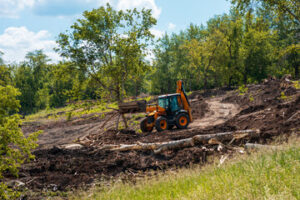When land clearing is conducted responsibly and in accordance with environmental regulations, it helps maintain healthy forests. It can also improve soil quality, reduce wildfire risks, and control pests that thrive in overgrown areas.

Cleared land offers improved safety for construction and farming projects by reducing fire hazards and accidents from rotting debris. It can also boost property value by making it more attractive to buyers or investors.
Many factors contribute to soil erosion, including rainfall patterns, weather conditions, and the presence of vegetation. While erosion is inevitable, it can be prevented with proper land clearing. During the clearing process, trees, shrubs, and brush are removed to prepare the site for construction or other uses. This also helps to prevent sedimentation and runoff, which can contaminate nearby lakes, streams, and wetlands.
Additionally, land clearing can help to control pest populations. Dense areas of vegetation attract pests, which can spread diseases and cause damage to the surrounding plants. Land clearing removes invasive species and other insects, preventing them from breeding in the area.
After the debris and invasive plants are removed, the land is graded and leveled. This can be done manually or with specialized machinery. The land is then seeded and mulched to encourage growth. The process can also include the use of erosion control barriers, if necessary.
Once the land is clear and ready for construction or agriculture, a thorough inspection is conducted. This includes checking for proper debris disposal, grading, and the use of erosion controls. This step ensures that the project is complete and meets all site requirements.
While some may question the necessity of land clearing, it is vital to maintaining a healthy property. In addition to removing unwanted debris and preventing fire hazards, it can also enhance the overall aesthetics of a property. This can make it more appealing to potential buyers or investors, and can increase the value of a home or commercial property. Additionally, a well-maintained property can provide a sense of security and safety to residents and visitors. In a time where environmental concerns are more prevalent than ever, professional land clearing services can be an invaluable asset for both homeowners and businesses alike.
Preventing Pests and Diseases
Dense bushes and trees make a cozy home for all sorts of unwanted pests, from mosquitoes to termites. Getting rid of their habitats through land clearing prevents them from growing in population and becoming a nuisance. This can be a health hazard for people using the land, and also makes it unappetising to potential buyers or residents.
Overgrown areas filled with rotting vegetation and dead trees pose all kinds of safety hazards, especially during rainy seasons when they can fall and injure or damage people. Additionally, they may harbor airborne viruses that can infect nearby plants and trees. Land clearing gets rid of these risks by removing all the unnecessary debris.
Another advantage of Land Clearing is that it promotes healthy growth of trees and plants by allowing them to get proper sunlight. When the soil is covered with dense vegetation, it blocks a significant amount of sunlight from reaching the ground and the roots of the plant. Therefore, it becomes difficult for them to grow and survive. Performing Land Clearing ensures that the soil is not covered by anything and can receive all the nutrients it needs from the sun.
Moreover, clearing land helps to reduce the risk of wildfires in fire-prone areas. It is crucial to perform regular Land Clearing in areas that are prone to wildfires because dense vegetation easily fuels them and can cause devastating fires. In addition to reducing the chances of fires, clearing the land regularly can also help keep animals and people safe by preventing them from sheltering in the undergrowth.
Lastly, clearing the land improves the access of vehicles and pedestrians on the property. Overgrown areas can become a tripping hazard and may also be prone to accidents from hidden rocks or other debris. Clearing the area allows people to move around freely and easily and makes the place more attractive to visitors. Ultimately, land clearing is beneficial for the environment, people, and the local economy. Investing in it early can save money in the long run and make a space more appealing for construction or farming activities.
Preserving Biodiversity
Land clearing services help preserve biodiversity by removing invasive species. These are plants, insects, and other creatures that are not native to the area and can wreak havoc on local ecosystems. The professionals who work in this field carefully inspect the landscape, differentiating non-native plants from those meant to thrive in the region. By eliminating invasive species, they can restore the area to its original condition.
The emergence of invasive species is one of the biggest threats to wildlife, and it’s important to be proactive about stopping them before they gain a foothold. Invasive species can harm wildlife, contaminate water supplies, and even disrupt the climate. Professionals who provide Land Clearing services are careful to identify these species and remove them before they cause any damage. This process also helps revitalize forests and grasslands, promoting ecological balance.
Invasive species can be particularly harmful to wildlife, and they may also affect the human population by impacting health and quality of life. These creatures can crowd out local fauna, leading to food shortages and increased competition for resources. This can have a direct impact on human health and even lead to social distancing. Land clearing companies that specialize in this service are able to spot these threats early and prevent them from spreading.
Responsible land clearing is essential for environmental stewardship and can create positive outcomes worldwide. In developing countries, it empowers communities and promotes sustainable agricultural practices. In areas prone to wildfires, it reduces risk and protects ecosystems and the people living within them. It can also encourage eco-tourism and promote local economic growth, allowing indigenous communities to sustain themselves.
However, the global demand for food is expected to increase significantly, and agricultural land clearing will likely increase along with it. Without rapidly increasing yields, the global supply of food will not be able to keep up with demand, and the world’s most biodiverse ecosystems could face dramatic increases in habitat loss. This is especially true in countries where demand outstrips food security and yields remain low. It is estimated that agricultural land clearing threatens 4-times more plant, bird, and mammal species than all other factors combined.
Preventing Damage to Future Structures
Whether it’s building homes, roads, or agricultural infrastructure, land clearing is a necessary step before construction can begin. Clearing the site helps prevent issues like uneven settling or structural damage that can occur once buildings are on the ground. In addition to removing vegetation and debris, the process may also involve grading. This involves leveling the land to create a stable and usable surface for construction, agriculture, or landscaping.
Lastly, land clearing helps prevent fire hazards. Dead plants and rotting tree stumps provide perfect habitats for wildfires to spread quickly. Luckily, land clearing services can prevent these risks by removing unwanted trees and reducing the number of weeds. By doing this, the risk of a fire is significantly reduced while also reducing allergies caused by pollen and airborne viruses that can be carried from nearby plants.
Land clearing can also be beneficial to farmers by preventing pests and diseases from infesting crops. Dense vegetation provides a hospitable environment for rodents and other pests, and can hinder farming efforts by blocking sunlight and inhibiting water flow. Land clearing removes these obstacles and helps farmers grow healthier crops that can be sold or eaten.
The land clearing process can also improve access and safety on a property. In areas with overgrown vegetation, vehicles, equipment, and people can become stuck or injured by tripping or falling objects. By removing debris and removing the risk of trees or shrubs falling on people, land clearing makes it easier and safer to navigate a property.
Despite the many benefits, land clearing is not without its challenges. When not done correctly, it can contribute to soil erosion and harm the health of the environment and local biodiversity. Land clearing companies should be able to demonstrate their environmental stewardship by utilizing sustainable practices that prevent erosion, protect water quality, and foster ecological balance. In addition, they should also commit to regular maintenance and inspections to ensure that cleared land is protected long-term.


